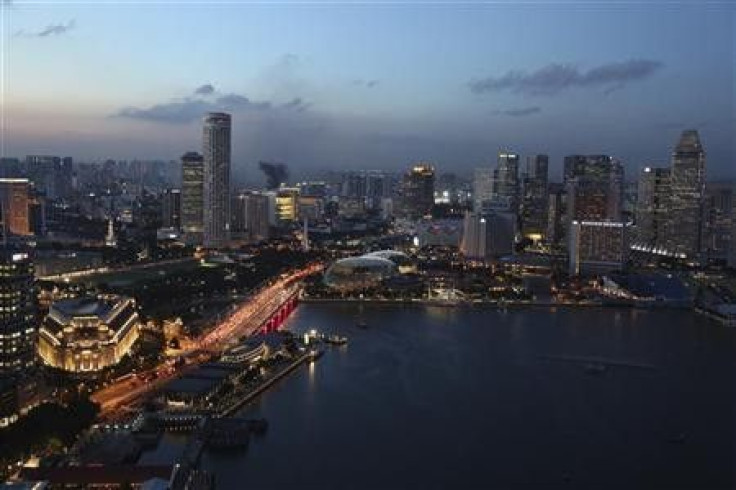Singapore Seeks To Cut Quota On Foreign Workers Amid Worries Over Immigration, Rising Labor Costs

The government of Singapore, which has long attracted talented foreign workers, now says it will cut the quota for foreign job-seekers and impose higher levies on companies that hire low-skilled foreigners.
While unveiling the new budget for 2013, Finance Minister Tharman Shanmugaratnam has also called on local business to improve the skills of their own workers in order to preclude the need of hiring from overseas.
However, Shanmugaratnam, who is also deputy prime minister, warned that the number of foreign workers cannot be reduced drastically.
"We cannot cut off the flow of foreign workers abruptly, but we have to slow the growth," he said in a speech announcing the budget.
“We are therefore making these further adjustments, and we have to do so in full knowledge of the difficulties they will pose for many of our companies.”
Immigration has become an increasingly prominent issue in Singapore, with local residents vocally complaining of the high number of migrants entering the tiny city-state in recent years and allegedly pushing up the cost of living and the price of real estate.
The finance minister stated that foreign workers and immigrants now account for more than one-third (33.6 percent) of the total workforce.
On a broader level, Singapore’s population has more than quadrupled since 2004 – from 1.1 million to 5.3 million – as the government of Prime Minister Lee Hsien Loong encouraged immigration to compensate for a modest birth rate.
Moreover, the last month, the government released a "white paper" predicting that the state’s population could soar by almost one-third to nearly 7 million by 2030, due largely to increased immigration. By that point, nearly half (45 percent) of the population will be comprised of foreigners.
Singapore businessmen have criticized the government’s plans to penalize the hiring of foreign workers through higher levies and tighter quotas.
“This is really killing a lot of businesses; many companies are dying,” Max Lee, managing director of Plasma Precision Technology Pte., told Bloomberg.
“We are losing competitiveness and productivity.”
Similarly, Adrian Ball, head of tax services at Ernst & Young Solutions LLP, warned that such cuts in foreign labor will hurt the country’s economic growth.
“This is a Darwinian budget for businesses in Singapore,” he said. “Survival of the fittest!”
The finance minister warned that Singaporean businesses will have to improve productivity, amidst a tighter labor market.
“Businesses have to respond in new ways to the tight labor market,” Shanmugaratnam said.
“We cannot carry on in the same way. If we pause now and postpone the restructuring of these industries, we will face the same problems of low productivity, low wages and low profitability in the future.”
Labor productivity in Singapore slipped by 2.6 percent last year, following growth of 1.3 percent in 2011, Reuters reported.
Shanmugaratnam added: “We need to intensify this economic restructuring and skills upgrading so as to achieve quality growth... If we do not do better in raising productivity, we will be caught in a situation where businesses lose competitiveness and wages eventually stagnate.”
The Straits Times newspaper reported that the quotas on foreign workers will most impact the services and marine sectors, including restaurants, retail shops and marine engineering firms.
Irvin Seah, an economist at Singapore's largest bank, DBS, warned that the new budget may force some multinational firms, long entrenched in the city-state, to depart due to higher costs.
"The restructuring has resulted in the deterioration in Singapore's overall competitiveness from many perspectives, be it from cost competitiveness or attractiveness to foreign direct investments," he said, according to Reuters.
However, jobs remain in abundance in Singapore (unemployment is below 2 percent), although wages are quite low, particularly for low-skill workers who must compete with migrants.
Last week, just after the release if the government’s white paper on population growth, but before the 2013 budget, Singaporeans staged a rare protest over rising immigration.
More than 4,000 people attended rally blaming immigrants for various ills affecting the small nation.
“The large crowd here shows the [ruling People’s Action Party] PAP government that they are not afraid any more, they don't want to hide behind a moniker on Facebook to show their displeasure," Gilbert Goh, a former opposition candidate for parliament, told Agence France-Presse.
"They are showing their deep displeasure with the white paper."
The government itself expressed ambivalence about rising population. In its white paper, the government declared: “If we do too little to address the demographic challenge, we risk becoming a steadily graying society, losing vitality and verve, with our young people leaving for opportunities elsewhere."
But then it added: "But if we take in too many immigrants and foreign workers, we will weaken our national identity and sense of belonging, and feel crowded out of our own home."
However, in a multicultural state like Singapore, terms like “natives” and ”immigrants” are rather fluid. In fact, the most populous ethnic group in the country, accounting for almost three-quarters of the population, are Chinese (i.e., themselves the descendants of immigrants from China). The “native” Malay people, who account for 13.4 percent of Singapore's population, are vastly outnumbered by the Chinese. Finally, Indians (which include the finance minister), represent about 9.2 percent of the population.
© Copyright IBTimes 2024. All rights reserved.











